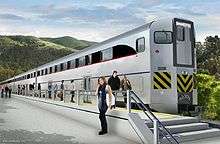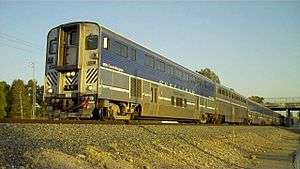Surfliner (railcar)
| Surfliner | |
|---|---|
|
"Surfliner" coach/baggage/cab car leading the Pacific Surfliner in Lake Forest, California. | |
|
Lower level accessible seating area of a Surfliner car. | |
| Manufacturer | Alstom |
| Built at | Hornell, New York |
| Family name | Superliner derived bi-level intercity railcar |
| Constructed | 2000–2002 |
| Number built | 62 |
| Formation | single car |
| Fleet numbers | 6000 series |
| Capacity | 90 passengers (coach cars) |
| Operator(s) | Amtrak & Caltrans as Amtrak California |
| Depot(s) | Los Angeles, Oakland |
| Line(s) served | Pacific Surfliner, Capitol Corridor, San Joaquin |
| Specifications | |
| Car length | 85 ft 0 in (25.91 m) |
| Width | 10 ft 2 in (3.10 m) |
| Height | 16 ft 2 in (4.93 m) |
| Entry | Step |
| Doors | 2 sets of bi-parting automatic doors per side |
| Maximum speed | 90 miles per hour (145 km/h) |
| Power supply | 480 V AC 60Hz Head end power |
| Bogies | GSI 70 |
| Braking system(s) | Air |
| Coupling system | AAR |
| Track gauge | 4 ft 8 1⁄2 in (1,435 mm) |
The Surfliner is the second generation of Superliner derived bi-level intercity railcars[1] owned by both Amtrak and California Department of Transportation (Caltrans) and operated under the Amtrak California brand of intercity corridor routes in Northern, Central and Southern California.
Alstom delivered the first order of cars for Amtrak between 2000 and 2001. A second order for the Caltrans Division of Rail was delivered in 2002. Amtrak's Superliner was used as the design baseline for the Surfliner, but several changes were made to the design to make the car more suitable for corridor services with frequent stops.
History
After the problematic delivery of the California Car in 1996, Amtrak set out to create a more advanced and reliable second generation intercity car for use on the busy San Diegan route (which was re-branded as the Pacific Surfliner when these cars were delivered). Several design changes were made to the cars including moving one of the restrooms to the upper level, adding a power outlet at every seat pair, moving the checked baggage compartment into the lower level of the cab car and creating a smaller galley on the lower level of the café car, enabling the upper level to be used for revenue seating.[1]
In February 1998, Amtrak ordered 40 Surfliner cars that were delivered by Alstom between 2000 and 2001[2] (all numbered in the 6xxx series). The first cars started operating on the Pacific Surfliner in April 2000.
In September 1999, Caltrans placed a smaller order for 22 cars.[2] 10 cars (numbered in the 6x5x series) are used to supplement the Amtrak-owned cars on the Pacific Surfliner and the other 12 (numbered in the 6x6x series) are used to expand the fleet used on the Capitol Corridor and San Joaquin.[3] These were the final Surfliner cars to be built and delivery was completed in 2002.
Description
Surfliner cars were delivered in several types: coach cars, café/coach cars equipped for food sales on the lower level, business-class cars which have two small galleys to allow an attendant to offer complimentary beverage service, and coach/baggage/cab cars equipped with coach seating, a checked baggage space on the lower level, and engineer's operating cab and headlights on one end, allowing the train to be operated in push-pull mode.[4][5] All Surfliner cars are equipped with overhead luggage racks, reclining seats with tray tables and footrests, reading lights, restrooms, AmtrakConnect WiFi, 120v power outlets, and a wheelchair ramp.[6] The Surfliner has a maximum speed of 90 mph (145 km/h).[7]
Future developments

California and a coalition of Midwest states (Illinois, Michigan and Missouri) placed an order for 130 third generation bi-level intercity cars with Sumitomo on November 6, 2012. The cars will be built by Nippon Sharyo at a new factory at Rochelle, Illinois. Eighty-eight cars will be going to the Midwest states and 42 will go to California.[8] The first cars were originally expected to be delivered by late 2015, with most cars (those purchased with federal stimulus funds) delivered by 2017 and the remainder in 2018. However, a prototype failed a compression test in 2015, resulting in a significant delay for redesign work. As of April 2016, the production is not expected to resume until 2018, placing the future of the cars in serious doubt because the federal funding expires in September 2017.[9]
This third generation car will have a few differences from the design of the Surfliner and California Car. The most major change is that cab cars will feature crash energy management technology. Major changes will also be made to the café car with the galley and lounge seating taking up two-thirds of the upper level with the other third used for revenue seating; the lower level will have a storage compartment for the café, a workstation table for crew and more revenue seating.[1]
See also
- California Car (railcar) - The first generation of Superliner derived bi-level intercity railcars.
References
| Wikimedia Commons has media related to Surfliner cars. |
- 1 2 3 "Bi-Level Passenger Rail Cars Standardized Technical Specification" (PDF). PRIIA 305 Next-Generation Equipment Committee. pp. 30–33. Retrieved July 20, 2013.
- 1 2 Alstom. "The Pacific Surfliner, Riding the California Coast" (PDF). Retrieved April 2, 2014.
- ↑ "California Surfliners". On Track On Line. Retrieved July 20, 2013.
- ↑ "Pacific Surfliner Names". On Track On Line. Retrieved July 20, 2013.
- ↑ "Amtrak - Pacific Surfliner". Retrieved June 29, 2013.
- ↑ "Amtrak Pacific Surfliners". Retrieved June 30, 2013.
- ↑ Amtrak (October 27, 2015). "Capital Investment Plan for Amtrak Equipment Deployed in State Corridor Service FY2016 – FY2020" (PDF). p. 43.
- ↑ "Nippon Sharyo and Sumitomo Corporation receive the Contract Award for 130 Bi-Level Passenger Cars from Caltrans and IDOT" (Press release). Nippon Sharyo. November 6, 2012.
- ↑ Tita, Bob (April 10, 2016). "Delays May Derail Stimulus Funding for Amtrak Railcars". Wall Street Journal. Retrieved August 23, 2016.
